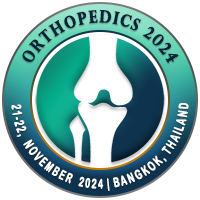
Elena Tchetina
Nasonova Research Institute of Rheumatology, Russian FederationTitle: Synovial Cytokine Profiling and Long-Term Clinical Outcomes in Patients with Knee Osteoarthritis Undergoing Corrective Osteotomy with Platelet-Rich Plasma or Stromal Vascular Fraction Post-Treatments
Abstract
Objective: To examine functional outcomes and synovial fluid (SF) cytokine concentrations in response to platelet-rich plasma (PRP) or stromal vascular fraction (SVF) post-treatments following open wedge high tibial osteotomy (HTO)
Methods: Six weeks after surgery, the knees of 10 patients with knee osteoarthritis were injected with autologous PRP (PRP subgroup), while another 10 patients were injected with autologous SVF (SVF subgroup) and monitored for 1.5 years. Pain assessment (VAS score) and functional activity (KOOS, KSS, Outerbridge, Koshino scores) were applied. SF was collected before and one week after PRP or SVF injections and tested for concentrations of 41 cytokines (Multiplex Assay).
Results: PRP subgroup performed better compared with the SVF subgroup according to KOOS, KSS, and VAS scores, while the SVF subgroup demonstrated superior results in Outerbridge and Koshino testing. In the PRP subgroup, a significant decrease in IL-6 and CXCL10 synovial concentrations was accompanied by an increase in IL-15, sCD40L, and PDGF-AB/BB amounts. The SVF subgroup demonstrated a significant decrease in synovial TNF?, FLT-3L, MIP-1?, RANTES, and VEGF concentrations while SF concentrations of MCP-1 and FGF2 increased.
Conclusion: Intra-articular administration of SVF produced more pronounced improvements related to cartilage regeneration while PRP post-injection resulted in a better functional outcome and pain control. Both post-treatments have a potential for increased tissue regeneration, presumably due to the downregulation of inflammation and augmentation of synovial growth factor concentrations.
Biography
Immunology and Molecular Biology Laboratory, Nasonova Research Institute of Rheumatology, Moscow, Russia

